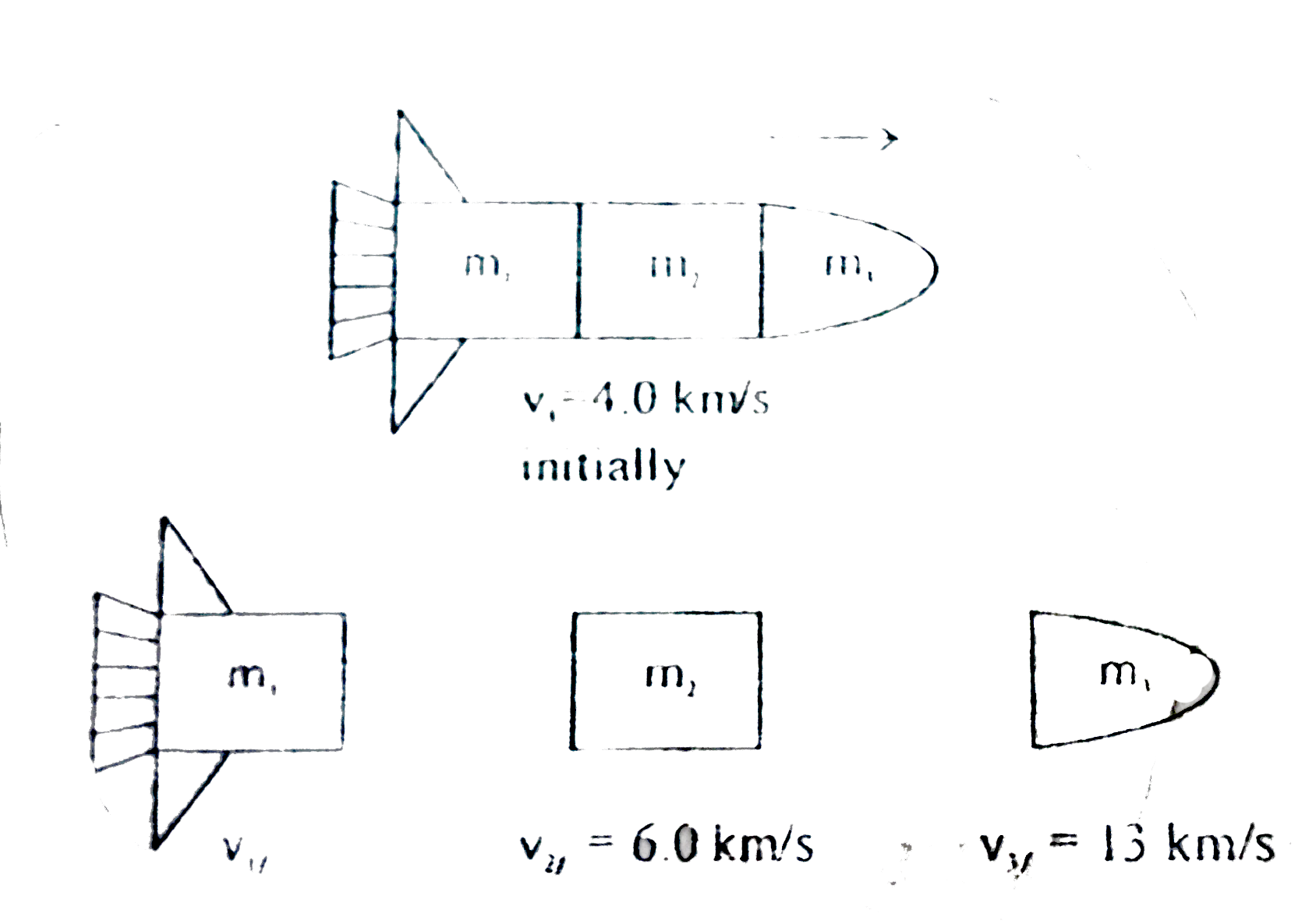A rocket moves horizontally with a constant velocity u at a height 1. A gu lded missile is fired vertically with a speed v when the rocket passes above it. Assuming that the missile always aims at the rocket with the constant speed v, find the time after which the missile strikes the rocket.

Let r=distance of separation between the rocket and missile after a time t. since, the missile always aims at the rocket with a constant speed v, it must move in a curve . At

time t if →r makes an angle θ with horizontal , the missile approaches the rocket with (vrel)∣∣=(v−ucosθ). Hence, during a taken dt
−dr=(v−cosθ)dt .........(i)
since, at t=0,r=1 and at t=τ,r=0
−∫01dr=∫τ0(v−cosθ)dt
or, vτ−u∫τ0cosθ=1 .....(ii)
Since, the missile hit the rocket, their x-displacements are same.
ΔxM=ΔxR
or, ∫τ0vMdt=∫τ0vRdt
or, ∫τ0vcosθdt=∫τ0udt
or, v∫cosθdt=uτ ......(iii)
and uτ=v∫τ0cosθdt........(iv)
Eliminating ∫τ0cosθdt from the Eqn. (ii) by substituting ∫τ0cosθdt=uvτ from the Eqn. (iv), we have
τ=vlv2−u2
Topper's Solved these Questions
Similar Questions
A roket fired vertically ascends with a constant acceleration g/3 for 1min. Its fuel is then all used and it continues to rise as a free body. What is the maximum height reached? What is the total time elapsed from the take off until the rocket strikes the earth?
View SolutionA shell is fired from a point O at an angle of 60∘ with a speed of 40m/s & strikes a horizontal plane throught O, at a point A. The gun is fired a second time with the same angle of elevation but a different speed v. If it hits the target which starts to rise vertically from A with a constant speed 9√3m/s at the same instant as the shell is fired, find v.
View Solution
Knowledge Check
A particle of mass m is moving horizontally with a constant velocity v towards a rigid wall that is moving in opposite direction with a constant speed u. Assuming elastic impact between the particle and wall, the work done by the wall in reflecting the particle is equal to
A(12)m(u+v)2B(12)m(u+v)C(12)muvDnone of theseA three part rocket begins intact as a single object in distant outer space, travlling to the right at 4.0km/h. The first stage (m1=950,000kg) explodes away from the rear of the rocket, with an unknown final velocity (vtf). Later, the second stage (m2=550,000kg) explodes away from teh rear with a final velocity to the right at 6.0km/s. The third stage (m2=350,000kg) ends up with a final velocity to the right of 13.0km/s. (All three move only along the x−axis . Ignore gravity. Assume that all parts of the rocket have constant masses.)

Find the impulse received by the first rocket stage.A3250000kg−km/secB4250000kg−km/secC780000kg−km/secD780000kg−km/secA rocket is fired vertically upwards and moves with net acceleration of 10m/s2. After 1 min the fuel is exhausted. The time taken by it to reach the highest point after the fuel is exhausted will be:
A10 secB20 secC30 secD60 sec
A relativistic rocket emits a gas jet with non-relativistic velocity u constant relative to the rocket. Find how the velocity v of the rocket depends on its rest mass m if the initial rest mass of the rocket equals to m0.
View SolutionA prototype of a rocket is fired from the ground. The rocket rises vertically up with a uniform acceleration of 54m/s2. 8 second after the start a small nut gets detached from the rocket. Assume that the rocket keeps rising with the constant acceleration.
(a) What is the height of the rocket at the instant the nut lands on the ground
(b) Plot the velocity – time graph for the motion of the nut after it separates from the rocket till it hits the ground. Plot the same velocity– time graph in the reference frame of the rocket. Take vertically upward direction as positive and g=10m/s2
View SolutionThe equation of motion of a missile are x = 3t, y = -4t, z = t, where the time ‘t’ is given in seconds, and the distance is measured in kilometres.

Based on the above answer the following:
At a certain instant of time, if the missile is above the sea level, where the equation of the surface of sea is given by 2x + y + 3z = 1 and the position of the missile at that instant of time is (1, 1, 2), then the image of the position of the rocket in the sea is
View SolutionA boy projects a stone vertically perpendicular to the trolley car with a speed v. If the trolley car moves with a constant velocity u, the time of flight of the stone is :
View SolutionA particlele is projected vertically upwards from the ground with a speed V and a speed v and a second particle is projected at the same instant from a height h directly above the first particel with the same speed v at an angle of projection θ with the horizontal in upwards direction. The time when the distance between them is minimum is
View Solution

